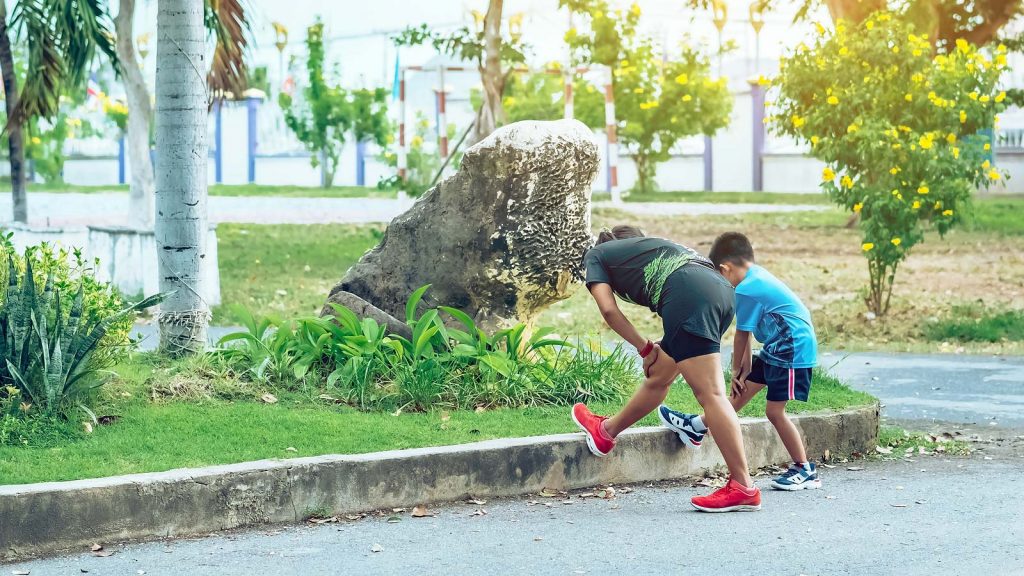
Most kids like to play all day long. Their energy levels are unmatched, and that’s why it’s even more critical to help them direct this energy into a lifelong habit – physical exercise. It plays a vital role in building your child’s overall health and wellbeing.
How Does Exercise Benefit Kids?
Active playtime is highly beneficial for kids from all aspects – physical, mental, and emotional.
- Physical benefits Kids develop strong muscles, flexible joints, slim body, improved endurance, improved balance, controlled blood pressure, and blood cholesterol levels, and more.
- Social-emotional benefits Regular exercise helps children deal with stress and pressure situations like a test or an exam better. Over time, they also learn to control other negative emotions like anxiety, restlessness, sleep disorders, etc. Exercising boosts their confidence, improves interactive social skills, and trains them to be cooperative team players.
- Cognitive-thinking benefits Physical activities among children help them in boosting their memory and processing speed. It enhances their attention span, ability to focus with improved listening skills.
How Much Exercise Does a Child Need?
According to the CDC guidelines, children should exercise regularly, fitting their age. The recommended levels for:
- Preschool children aged between 3 to 5 years – Stay physically active through the day for balanced growth, bone strength, and development.
- School children and adolescents aged between 6-17 years – An hour or more moderate-to-vigorous intensity physical activity every day. Activities like aerobics daily or running, jumping, climbing, push-ups, etc., at least three days a week.
Best Exercises for Kids
Running
Kids love running around chasing each other. It’s the most accessible form of exercise, and you can encourage your kids to do it either indoors or outdoors. To make it more fun, you can combine it with other active games like relay race, frog race, or add obstacles throughout their running area.
Dancing
Dancing is fun at any age – it boosts self-confidence and lifts your mood instantly. Whether kids are dancing free-spirited at home or taking professional training, the movement process makes them more aware of their bodies and how much it’s capable of.
Put on their favorite music or dance video online and let them dance their heart out. Dancing helps develop a fitter body, mind, and soul.
Skipping
Skipping is a great brain booster exercise for kids. It requires homogeneous coordination between mind and body, which leads to improved overall functioning. There are many skipping games you can introduce to your kids, including jumping rope, scissor jumps, cross rope, skipping tag, hopscotch, etc.
Squats, planks, and lunges
These forms of exercises, if done correctly, have long-term benefits for all kinds of sports and fitness activities. If your child is too young, teach them how to bend those knees (at a right angle) and keep them in line with feet for squats and lunges. Similarly, for planks, adults should demonstrate how to do it correctly. To make it more interesting, do these exercises with them for the first few times, and kids will start doing them independently.
Superheroes
Enacting a classic superhero movement is fun for every child. While it’s simple to do it every day, be sure that kids perform it correctly to avoid any strain on body parts. Kids can lay flat on their bellies and then lift their arms and feet off the ground like Superman flying in the air. Hold the posture for a few seconds and repeat it a few times.
Jumping
It needs no particular skill or practice – give kids a safe place to play, and they will mostly be jumping like a jack. Jumps build muscle strength, endurance, and cardiovascular fitness. Parents can install a trampoline at home too for kids to try different kinds of jumping. Apart from regular jumping, kids can try other forms like hurdle hops, criss-cross feet, one-foot hop, etc.
Crab Walk
It may sound a little funny at first, but it’s a lot of fun – show the kids how to sit with their feet in front and hands behind and lift their bumps off the ground to start walking like a crab. Crab walk involves various muscle groups in the body that helps in shaping the kid’s healthy body.
Bear Crawl
If your kids find crab walk difficult, they can try bear crawl instead. It’s simpler and essentially requires walking on all four limbs – both hands and legs. Like crab walk, the bear crawl is a full-body exercise.
Ball Game
The ball game requires minimal space and is an excellent form of exercise. Bouncing a ball against the wall, hitting balls into a target area, rolling the ball back and forth with another player, etc., are different types of ball games that kids love playing. Just ensure that kids are bouncing the ball in a safe area and at all times, wearing protective gear if they are playing more intense games with hard balls.
Yoga and Stretching
For kids, practicing yoga may not come naturally to them, but it’s a great form of exercise and disciplined life in the long-term. Kids can try some of the easy poses like a tree pose, cobra, happy baby, upward facing dog, etc.
Alternatively, kids can do some simple stretches to keep their muscle function healthy. Start with stretches like finger-to-toes, arm circles, arms to the sky, calf and hamstring stretch, etc. These stretches help transition kids into a relaxed and happy state of mind.
Parents Take the Lead
Parents with young children need to take the lead in encouraging regular exercise. Even the youngest children find their way to smartphones and tablets leading them to chronic inactivity. Walking and talking is a great way to start an exercise program. Your little one will appreciate the extra attention and be ready to add more strenuous movements to their routine. And yes parents, you’ll benefit from exercising with your child as well!
